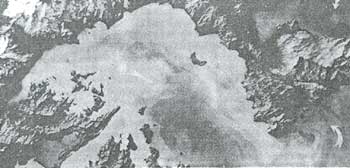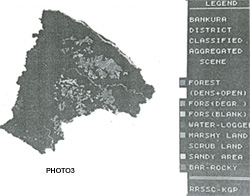| GISdevelopment.net ---> AARS ---> ACRS 1991 ---> Oceanography |
The special processing of the
ocean micro-information of Remote Sensing in the sea area east to Hong
Kong
Chen Xuelian, Luo Dan
Institute of Pearl River Water Resources
Comm. Guangzhou 510611, P.R. China
Institute of Pearl River Water Resources
Comm. Guangzhou 510611, P.R. China
As is well know, in the processing of satellite Remote Sensing information, the information of land features is strong with great difference, easy to be identified and extracted. However, the information of material in the water, such as ocean aquatics (algae), submerged reef and suspended sediment, is quite weak. Even it is processed by an image- processing system in a large - computer, it is still difficult to get the satisfactory result because of the weakness of information. Although the image displayed on the monitor can be identified with difficulty on sometimes, the information may be blurred again on actual scanning negative films or enlarged photos. This was the case when we processed the TM image of the algae in Daya Bay, the image of Mias Island Submerged Reef in Bohai Bay and the information of suspended sediment concentration in the sea are in the vicinity of Hong Kong. The difficulty in that case was that it was impossible to be everything again after the scanning of negative films and the purchase of photos. As a remedy, we extracted the micro - information on the Remote Sensing ocean image using the chromatic sensitivity of silver halide and achieved.
Following are the principles and the extraction procedures :
Principles
Silver halide black and white sensitive films scan be categorized as X-ray film, ultraviolet film, blind photography film, chromatic film, panchromatic film and infrared film according to their degree and range of sensitivity to various color lights. We mainly used the blind photography films, chromatic films and infrared films for the experiment. The chromatic sensitivity of these kinds of films are shown in Fig.1.

Figure 1 The Sensitivity of Silver Halide Black-and-White Films
It can be seen in Fig. 1 that the sensing range is the most narrow for blind photography films, and coming second is that of chromatic films, Blind Photography films can be sensitized only by ultraviolet - ray, blue-light and green light, as well as white light because it contains green blue lights. This nature of silver halide blind photography films and chromatic films can be utilized. The colors of the micro information on the satellite image to be extracted method on the color mixing method (i.e blue + green = cyan, green + red = yellow , red + blue = pinkish red, red + green + blue = yellow + blue = pinkish red + green = cyan + red = white), so that white blue or blue-green can be reflected from the image and sensitize a blind photography film or a chromatic film. In this way, the micro information can be extracted.
Extraction Procedures
As an illustration, described below is the extraction procedure for the micro-information of the suspended sediment distribution in the sea areas east to Hong Kong including Depeng and Daya Bays.
The original image is a TM image of Hong Kong International Airport and Deep Harbour. Hong Kong is an excellent deep port with no large river emptying in to the around sea area. Therefore, the small in the area. Fig. 2(A) is the original image of this area, from which the suspended sediment distribution in sea water is difficult to be seen although it can be identified under strong illumination. In the extraction experiment, a blind photography film is used as a negative film. First, a special focusing film is put into Durst 1840 color Enlarger and projected onto the base board, with the size of projection being slightly larger than the original TM image to be processed. After focusing, a blind film is put in. The aperture is adjusted to f11/300. on the two sides of the base board two tungsten halogen lamps (1300w) are set, respectively for illumination 2.5m far from the board and 1.2m height - blue filters. Under the illumination, the micro-information of sediment reflects strong white blue light, sensitizing the blind appears to be dark black and the films does not sensitizes for this color. After development and enlargement, this difference is even enlarges. At lat, the micro - information of sediment distribution and the flow pattern of suspended sediment (tape shape or votex shape) in the sea area east to Hongkong including Dapeng and Daya Bays is well displayed (Fig. 2(B)). A good result is achieved.

Figure 2)a) The very small sediment concentration is difficult to be displayed in the sea area to Hongkong

Figure 2(b) After extraction of Mirco-information, the flow field of suspended sediment is very clear

Location Map - Fig 1



Figure 4